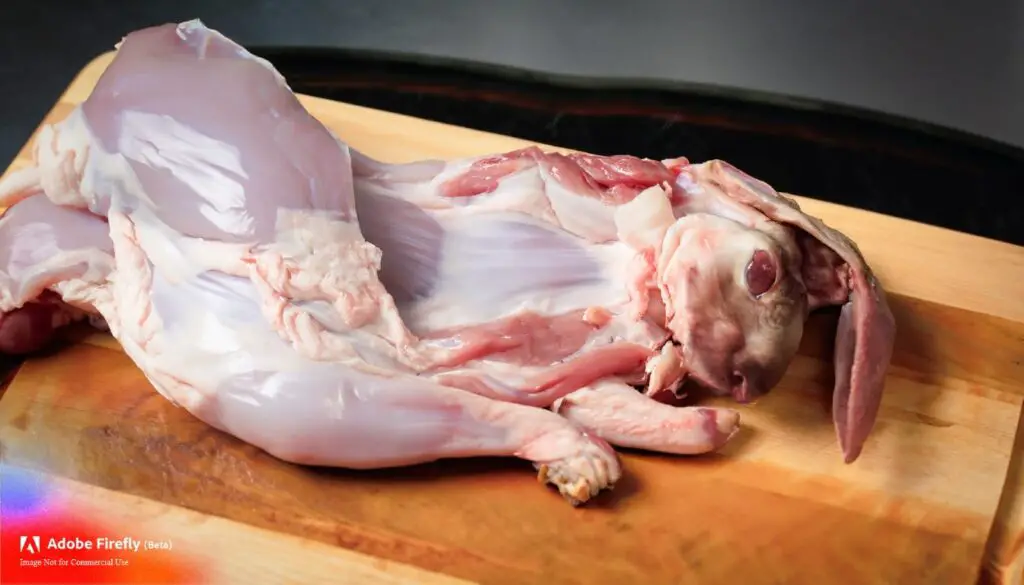
Determining whether rabbit meat has gone bad involves assessing its appearance, smell, and texture. Here are some key indicators to help you tell if rabbit meat is no longer suitable for consumption:
- Examine the Color: Fresh rabbit meat should have a pinkish or light red color. If the meat appears gray, greenish, or has developed any unusual discoloration, it may be a sign of spoilage.
- Check for Foul Odors: Fresh rabbit meat has a mild, slightly sweet aroma. If the meat emits a strong, unpleasant, or sour smell, it’s likely spoiled. This odor is often a clear indicator of bacterial growth.
- Inspect the Texture: Rabbit meat should have a firm and slightly moist texture. If you notice any sliminess, stickiness, or a mushy consistency, it’s a sign of spoilage. The texture of spoiled meat can be noticeably different from fresh meat.
- Look for Mold or Off-Putting Growth: Visible mold or unusual growth on the surface of the meat is a definite sign of spoilage. Avoid consuming meat with any visible signs of mold or unusual substances.
- Check the Packaging: If the rabbit meat is vacuum-sealed or packaged, inspect the packaging for any signs of damage, such as tears, leaks, or punctures. Damaged packaging can lead to contamination and spoilage.
- Consider the Use-By or Sell-By Date: If the meat is packaged with a use-by or sell-by date, check it to ensure the meat is still within its recommended consumption period. However, these dates are only guidelines, and the meat’s condition should be your primary indicator.
- Trust Your Senses: Your senses, particularly your sense of smell, are crucial in determining the freshness of rabbit meat. If the meat smells unusual or unappetizing, it’s best to discard it.
- Perform the “Sniff Test” After Cooking: Even if the rabbit meat appears and smells fine before cooking, it’s important to perform a “sniff test” after cooking. If the cooked meat emits an unpleasant or off-putting odor, it’s not safe to eat.
It’s essential to handle and store rabbit meat properly to minimize the risk of spoilage. Keep rabbit meat refrigerated at temperatures below 40°F (4.4°C) and use it within a few days of purchase. If you plan to store it for a more extended period, consider freezing it in a well-sealed, airtight container or freezer bag.
When in doubt about the freshness of rabbit meat, it’s safer to err on the side of caution and discard it. Consuming spoiled meat can lead to foodborne illnesses, which can be potentially harmful.

7 Health Benefits of Rabbit Meat:
- Lean Protein: Rabbit meat is a rich source of lean protein, making it an excellent choice for those looking to increase their protein intake without excessive fat content.
- Low in Fat: Rabbit meat is lower in fat compared to meats like beef, pork, and lamb. It is an ideal option for individuals aiming to reduce their fat consumption.
- Low in Calories: Rabbit meat is relatively low in calories, making it a suitable choice for those on a calorie-restricted diet.
- High in Vitamins: Rabbit meat is a good source of essential vitamins such as B vitamins (especially B12), niacin, and riboflavin, which are important for energy metabolism and overall health.
- Rich in Minerals: It contains minerals like iron, phosphorus, and selenium, which are vital for various bodily functions, including the production of red blood cells and antioxidant protection.
- Omega-3 Fatty Acids: Rabbit meat contains omega-3 fatty acids, which are beneficial for heart health and may help reduce inflammation.
- Low Cholesterol: It has lower cholesterol levels compared to some other meats, contributing to heart-healthy eating.
4 Dangers of Eating Rabbit Meat:
- Bacterial Contamination: Rabbit meat, like all meats, can carry harmful bacteria. Proper handling, cooking, and storage are essential to prevent foodborne illnesses.
- Parasites: Wild rabbits may carry parasites that can be transmitted to humans if the meat is not adequately cooked.
- Allergies: Some individuals may be allergic to rabbit meat, leading to adverse reactions upon consumption.
- Overconsumption of Game Meat: Eating large amounts of game meat, including rabbit, can lead to “rabbit starvation” due to its extremely lean nature. It’s important to have a balanced diet.
Food-borne Illnesses From Rabbit Meat
Rabbit meat can be a healthy and delicious source of protein, but it is important to be aware of the risks of foodborne illness. Rabbits can carry a number of bacteria and parasites that can cause illness in humans, including:
- Salmonella: Salmonella is a common bacterium that can cause diarrhea, fever, and abdominal cramps.
- Campylobacter: Campylobacter is another common bacterium that can cause diarrhea, fever, and abdominal cramps.
- Listeria: Listeria is a serious bacterium that can cause miscarriage, stillbirth, and newborn death in pregnant women. It can also cause serious illness in people with weakened immune systems.
- Toxoplasma gondii: Toxoplasma gondii is a parasite that can cause serious illness in pregnant women and people with weakened immune systems.
To reduce the risk of foodborne illness from rabbit meat, it is important to:
- Cook rabbit meat thoroughly. Rabbit meat should be cooked to an internal temperature of 165 degrees Fahrenheit.
- Avoid cross-contamination. Wash your hands thoroughly with soap and water before and after handling rabbit meat. Keep raw rabbit meat separate from cooked food and other foods that will not be cooked.
- Refrigerate rabbit meat promptly. Refrigerate rabbit meat within two hours of cooking or purchase.
- Freeze rabbit meat promptly. If you are not going to cook rabbit meat right away, freeze it immediately.
If you experience any symptoms of foodborne illness after eating rabbit meat, such as diarrhea, fever, or abdominal cramps, seek medical attention immediately.
Here are some additional tips for preventing foodborne illness from rabbit meat:
- Buy rabbit meat from a reputable source. Ask your butcher about their food safety practices.
- Inspect the rabbit meat before you buy it. Make sure that the meat is fresh and that there are no signs of spoilage.
- Use a meat thermometer to ensure that the rabbit meat is cooked thoroughly.
- Clean and disinfect all surfaces that come into contact with rabbit meat.
- Wash your hands thoroughly with soap and water after handling rabbit meat.
By following these tips, you can help to reduce your risk of foodborne illness from rabbit meat.
How Can You Tell If Rabbit Meat Is Safe to Eat?
To ensure rabbit meat is safe to eat, follow these guidelines:
- Inspect the Meat: Check for any signs of spoilage, such as unusual odor, off-putting color, sliminess, or mold. If you detect any of these, discard the meat.
- Storage: Ensure that rabbit meat is stored at proper refrigeration temperatures (below 40°F or 4.4°C) or adequately frozen.
- Cook Thoroughly: Cook rabbit meat to an internal temperature of at least 160°F (71°C) to kill any potential harmful bacteria or parasites.
How Do You Know If Rabbit Meat Is Rotten?
Rabbit meat is likely rotten if it exhibits the following signs:
- Foul, unpleasant, or sour odor.
- Unusual discoloration, such as gray or greenish patches.
- Sliminess or a sticky texture.
- Visible mold or unusual growth on the surface.
- Abnormal or off-putting appearance.
Is It Safe to Eat Rabbit Meat in the Summer?
Yes, it is safe to eat rabbit meat in the summer if it is handled, cooked, and stored properly. The same food safety precautions apply to rabbit meat in hot weather as they do in any other season. Ensure that the meat is stored at safe temperatures (below 40°F or 4.4°C) and cooked to the recommended internal temperature to kill any harmful bacteria.
FAQ’S about Consuming Rabbit meat
What Color Should Rabbit Meat Be?
Fresh rabbit meat should have a pinkish or light red color. The color may vary slightly depending on factors like the age of the rabbit and its diet.
Is Rabbit Meat Dark or Light?
Rabbit meat is generally considered a light meat, similar in color to poultry. It is lighter in color than red meats like beef or lamb.
Why Don’t We Eat Rabbit Meat?
The consumption of rabbit meat varies by region and culture. In some areas, rabbit meat is popular and readily consumed. In others, it may be less common due to factors like cultural preferences or limited availability.
Is Rabbit Meat Hard to Digest?
Rabbit meat is generally considered easy to digest due to its lean and tender nature. It is often recommended as an alternative to heavier, fatty meats.
Are Rabbits Unhealthy to Eat?
Rabbit meat is a nutritious and healthy protein source when handled, cooked, and consumed properly. Like any meat, it can pose health risks if not prepared correctly or if wild rabbits are not properly inspected for parasites.
What Affects Rabbit Meat Quality?
Several factors can affect the quality of rabbit meat, including the rabbit’s diet, age, handling, and cooking methods. Proper care and preparation are essential to maintain meat quality.
How Long Do You Keep Meat Rabbits?
The age at which rabbits are slaughtered for meat depends on their breed and desired meat quality. Generally, rabbits are harvested for meat between 8 and 12 weeks of age to achieve tender, flavorful meat.
Is rabbit meat healthier than other meats?
Rabbit meat is often considered a healthier option than some other meats due to its low fat and calorie content. It’s also rich in nutrients like protein, B vitamins, and minerals.
Can you eat wild rabbit meat?
Yes, you can eat wild rabbit meat, but it’s important to handle and cook it properly to reduce the risk of disease transmission and ensure safety.
How do you store rabbit meat?
Rabbit meat should be stored in the refrigerator at temperatures below 40°F (4.4°C) or frozen for longer storage. Proper packaging, such as airtight containers or freezer bags, helps maintain quality.
Can you eat rabbit organs?
Yes, rabbit organs like the liver, heart, and kidneys are edible and are considered delicacies in some cuisines. Ensure they are properly cooked before consumption.
What are some popular rabbit meat dishes?
Rabbit meat is used in various dishes worldwide. Some popular preparations include rabbit stew, grilled rabbit, rabbit ragu, and rabbit pâté.
Is rabbit meat sustainable?
Rabbit meat is often considered a sustainable protein source because rabbits reproduce rapidly and require relatively small amounts of feed and space compared to other livestock.
Are there any health concerns with rabbit meat?
While rabbit meat is generally safe to eat, individuals with rabbit allergies should avoid it. Additionally, ensure it is cooked thoroughly to eliminate potential health risks.
Can you eat the skin of a rabbit?
Rabbit skin is edible, but it is often removed before cooking because it can be tough. Some recipes may call for the skin to be left on, especially if the rabbit is roasted or grilled.
Are there any specific cooking tips for rabbit meat?
Rabbit meat can become dry if overcooked, so it’s essential to monitor cooking times closely. Braising, stewing, or marinating can help keep the meat tender and flavorful.
Can you eat domesticated rabbit meat?
Yes, domesticated rabbit meat is commonly consumed and is readily available in many regions. It is raised specifically for meat production and culinary purposes.
Is rabbit meat considered a delicacy in any cuisine?
Yes, rabbit meat is considered a delicacy in various cuisines, including French, Italian, Spanish, and North African cuisine. It is often featured in traditional dishes and gourmet recipes.
How do you prepare and cook rabbit meat?
There are numerous ways to prepare and cook rabbit meat, including roasting, grilling, braising, stewing, and frying. Recipes may vary depending on cultural and regional preferences.






